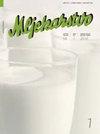The differences in production of Holstein Friesian and Holstein Friesian x Norwegian Red F1 crossbreeds
IF 1.1
4区 农林科学
Q3 AGRICULTURE, DAIRY & ANIMAL SCIENCE
引用次数: 0
Abstract
The aim of this study was to compare the production, health and fertility traits of Holstein Friesian (HF) and their F1 crosses with Norwegian Red cows (HF x NRF F1). Only the production data’s from finished first lactations of the total 57 HF x NRF F1 crosses and 401 HF cows, and for health and fertility traits of 120 HF x NRF F1 crosses and 255 HF cows, were used. The differences in production traits were tested by a least square means using the GLM procedure in SAS. The milk yield in both lactation (standard 305 days and full lactation) were higher in HF x NRF F1 crosses for approximately 400 kg, but without significance. The differences in production traits (fat and protein (kg and %)) were significant (p<0.001; p<0.05) with higher values for HF x NRF F1 crosses comparing to HF cows, with exception of protein in full lactation. Regarding the fertility traits, HF x NRF F1 crosses had a better conception rate (+1.58 %), a lower number of the insemination per pregnancy (-0.43) and a shorter duration of the service period (-22.2) comparable to HF cows. F1 crosses had better health traits (with except for hoofs problem) comparing to HF cows, they had less cows with mastitis (-11.9 %), ketosis (-0.5 %), retained placenta (-4.8 %) and dislocation of the abomasum (-1.0 %), respectively. Because of the fact that all results were obtained on the basis of data from the first lactation cows, it is necessary to do more analyses of all studied traits in subsequent lactations, in order to get a much clearer insight into the studied issues.荷斯坦弗里西亚和荷斯坦弗里西亚x挪威红F1杂交品种的产量差异
本试验旨在比较荷斯坦弗里马(HF)及其F1杂交品种与挪威红牛(HF × NRF F1)的生产、健康和育性性状。本研究仅使用57个HF × NRF F1杂交组合和401头奶牛的首次产奶量数据,以及120个HF × NRF F1杂交组合和255头HF奶牛的健康和生育性状数据。利用SAS的GLM程序,用最小二乘法检验生产性状的差异。近400 kg HF × NRF F1杂交在泌乳期(标准305天和完全泌乳期)产奶量均较高,但无显著性差异。生产性状(脂肪和蛋白质(kg和%))差异显著(p<0.001;p<0.05), HF × NRF F1杂交值高于HF奶牛,但全乳期蛋白质含量除外。在育性性状方面,HF与NRF F1杂交的受孕率较高(+ 1.58%),单次受精卵数较低(-0.43),受精期较短(-22.2)。与HF奶牛相比,F1奶牛具有更好的健康性状(除蹄问题外),乳腺炎(- 11.9%)、酮症(- 0.5%)、胎盘残留(- 4.8%)和皱胃脱位(- 1.0%)的发生率分别较低。由于所有结果都是基于第一次泌乳奶牛的数据得出的,因此有必要在随后的泌乳中对所有研究性状进行更多的分析,以便更清楚地了解所研究的问题。
本文章由计算机程序翻译,如有差异,请以英文原文为准。
求助全文
约1分钟内获得全文
求助全文
来源期刊

Mljekarstvo
Agricultural and Biological Sciences-Animal Science and Zoology
CiteScore
1.90
自引率
41.70%
发文量
18
审稿时长
12 weeks
期刊介绍:
Mljekarstvo is an open access, peer-reviewed international quarterly scientific journal. The first issue was published in 1951, by the Croatian Dairy Operators'' Association (today: Croatian Dairy Union, publisher). In a paper at a Union conference held 28 October 1951 in Zagreb it was said: "Our desire is that this magazine does not meet the fate of its predecessors, but that it continues to reflect the creative efforts and to provide guidelines for the producers as well as all other operators employed in the dairy industry."
It is our pleasure today to say that wishes of the enthusiasts who attended the conference have come true, and the magazine Mljekarstvo during the last six decades was a reflection of the creative efforts of numerous dairy scientists and experts, and through its texts it served as a guideline in improving production and processing of milk and dairy products. Mljekarstvo has been following all the achievements of the dairy profession in Croatia, and it also gives the short surveys of world achievements. The result of the research of local and foreign scientists and experts always find their place in the magazine Mljekarstvo. It has been edited by our outstanding dairy experts employed at colleges, research institutions and dairy companies.
 求助内容:
求助内容: 应助结果提醒方式:
应助结果提醒方式:


